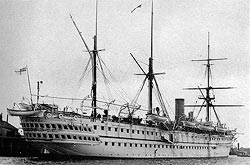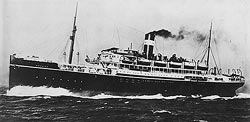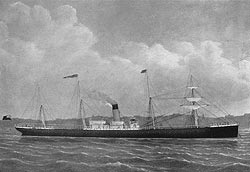1866 - Return of the QUEENS
A Naval Experience
 |
| Troopship H.M.S. Malabar at Southampton. (Click to enlarge) |
The 70th Regiment was followed in India by the 1st Battalion of the Queen’s Regiment. A second battalion had been raised in 1857. No sooner had 1st Queen’s arrived than half the battalion was sent back to Aden and the rest to Haiderabad in Sind which Queen’s officers had once visited on their way to Afghanistan. The battalion was eventually re-united at Poona in 1868 but it rarely remained concentrated due to the number of detachments required. In 1870 it marched south to Belgaum before returning to Poona and Bombay. In 1878 it moved by rail to Mhow and early in 1879 to Deolali to await embarkation for England. As usual, soldiers were allowed to transfer to other units in order to remain in India. But the bounty which had been admissible for those volunteering to do so had been withdrawn, and there were few who applied. Those who did were transferred to 2nd Queen’s which by then was at Bareilly having arrived from Malta in 1878 where it had been sent at short notice in 1877 on the outbreak of the Russo-Turkish War.
 |
| Troop Ship on which "The Queen's" sailed to Hong Kong, April 13th 1927. (Click to enlarge) |
1st Queen’s voyage around the Cape of Good Hope in 1866 had taken 109 days from Ireland, the introduction of propeller-driven ships having considerably reduced the need to divert to refuel. The opening of the Suez Canal in 1869 revolutionised the passage to India. In 1871 the 70th Regiment’s voyage from Cork to Bombay took just thirty days. There were five troopships on the India run, manned by the Royal Navy and naval routine prevailed.
Life was not easy for the troops. An NCO of 2nd Queen’s recorded his views when the battalion sailed from Malta to India through the Canal in 1878. It seemed that the seamen regarded the soldiers as inferior beings, always in the way. Nevertheless they assisted in many ways. They formed two watches, one of which was always available. They helped reeling in the log, hoisting ashes from the engine room, swabbing the decks, providing assistant bakers, cooks and mess orderlies.
 |
| SS Lancashire 1899 Bibby Line Ship. Courtesy of the Bibby Line. (Click to enlarge) |
Sleeping accommodation was crowded. Although one hammock and one blanket were issued each evening and returned to the store the following morning the hooks only permitted half the hammocks to be slung. Fortunate was the man who could find a cosy corner where he could roll himself in his blanket unobserved and undisturbed, although if he did not rouse himself before daylight and the bugle call for swabbers he risked a ducking from the hosepipe.
The ration scale for soldiers was less than for sailors on a six to four basis, six soldiers received the same amount as four sailors. There was no cold storage and fresh meat when issued was killed on board. Bread was supplied twice a week, biscuits the remaining five days. Salt beef, salt pork with pea soup and pickles, and tinned beef and mutton filled the menu when fresh meat was not supplied. “Duff”, a concoction of flour, fat, raisins and sugar, made by mess orderlies and boiled in a bolster-shaped bag, was the special meal provided on Wednesdays and Sundays. A pint of porter per man, thick with hops, was issued daily after the midday meal. Defaulters were deprived of this luxury. On “duff” days many were the exchanges - duff for porter, the younger soldiers preferring the former.
The writer complained that notwithstanding overcrowding and scanty food the voyage would have been enjoyable except that someone in authority had conceived the idea that marching order parades would assist the troops to keep their things together and prevent losses. “Please to remember” he wrote “that we were wearing scarlet kersey frocks, blue serge trousers and black leather leggings; also that the valise equipment consisted of innumerable straps, two hard back pouches and an auxiliary pouch known as the “ball bag” and that the valise contained the complete kit; further, that we were packed like sardines”.
Before leaving Malta each man was supplied with a sea kit which consisted of a thin unlined blue serge jacket and trousers, a suit of white drill, blue stockinette cap, one pound of tobacco and a bar of marine soap. As the weather became warmer the thin serge suit was much appreciated. Despite the parades, inspections and fatigues, the want of exercise and other occupation made time hang heavily. Games of cards and “House” were the main recreations, the stakes being chunks of tobacco cut from the sea-kit supply. Money was scarce; no pay was issued on board as the sea-kit had to be paid for.
Related
